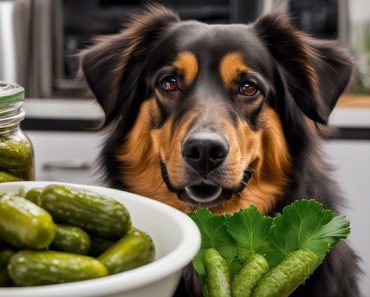As a dog owner, you may often find yourself wondering about the foods that are safe to share with your furry friend. One common question that arises is whether dogs can eat basil. Well, I consulted with my trusted veterinarian to get the answer, and I’m here to reveal the advice.
The good news is that basil is generally safe for dogs to eat in moderation. In fact, incorporating this aromatic herb into your dog’s diet can provide several health benefits. However, it’s essential to be aware of the potential risks and considerations when feeding basil to your four-legged companion.
Can Dogs Eat Basil? Yes, it is usually alright for your pup.
- Basil is generally safe for dogs to eat in moderation.
- Feeding basil to dogs can provide several health benefits.
- However, there are risks and considerations to keep in mind when feeding basil to dogs.
- Consult with your veterinarian for guidance on incorporating basil into your dog’s diet.
- Always monitor your dog for any adverse reactions or digestive upset after consuming basil.
What is Basil and Can Dogs Have It?
Basil is a popular herb that belongs to the mint family and is widely used in cooking. It has a fragrant aroma and a slightly spicy taste. Dogs can eat basil in small amounts, and it is generally safe for them.
Basil contains essential oils with antioxidant and anti-inflammatory properties, making it beneficial for dogs’ health. These properties can help enhance their immune system and reduce inflammation. Additionally, basil is rich in vitamins and minerals that contribute to their overall well-being.
When it comes to feeding basil to your furry friends, it’s important to stick to fresh basil and avoid processed forms that may contain harmful additives. Fresh basil is the best way to ensure your dog gets the full benefits without any unnecessary risks.
- Types of Basil: There are several types of basil, including sweet basil, lemon basil, and Thai basil. Each variety has its own unique flavor and properties, so you can experiment and find the one your dog enjoys the most.
- Benefits of Basil for Dogs: Feeding basil to dogs can provide a range of benefits, such as supporting their immune system, aiding digestion, and promoting overall well-being.
- Safety of Basil for Dogs: While basil is generally safe for dogs, it’s crucial to feed it in moderation and keep an eye out for any adverse reactions. Like any new food, it’s best to introduce basil gradually and observe how your dog responds.
Now that we understand what basil is and how it can benefit dogs, let’s explore the specific health benefits of feeding basil to our four-legged companions in the next section.
Health Benefits of Feeding Basil to Dogs
Feeding basil to dogs can provide a range of health benefits. Basil has anti-inflammatory properties that can help reduce inflammation and alleviate pain in dogs with conditions like arthritis. It aids digestion and improves gastrointestinal health, reducing issues like gas and bloating. Basil also has antimicrobial properties that can prevent bacterial and fungal infections in dogs. Additionally, basil is a good source of vitamins and minerals which are essential for overall health and wellbeing in dogs.
If you’re looking to boost your dog’s immune system, basil can be a great addition to their diet. The antioxidants present in basil can help strengthen their immune system, providing them with an added layer of protection against illnesses and diseases.
Not only does basil support the digestive system, but it can also aid in the absorption of nutrients. This can be particularly beneficial for dogs with sensitive stomachs or digestive issues. By incorporating basil into their diet, you can help improve their overall digestive health.
As dogs age, they may experience joint discomfort or stiffness. Basil’s anti-inflammatory properties can help reduce inflammation in the joints, providing relief and improving their mobility. It can be particularly helpful for dogs with arthritis or other joint-related issues.
Just like humans, dogs can experience stress and anxiety. Basil’s calming properties can provide stress relief for dogs, helping them relax and cope with stressful situations. Whether it’s separation anxiety, noise phobia, or general anxiousness, incorporating basil into their diet can promote a sense of calm and well-being.
In addition to its numerous health benefits, basil also offers valuable nutritional benefits for dogs. It is rich in vitamins A, K, and C, as well as minerals like calcium, iron, and potassium. These nutrients are essential for maintaining a healthy immune system, promoting bone health, and supporting overall cellular function.
Overall, feeding basil to dogs can be a natural and nutritious way to support their health and well-being. However, it’s important to introduce basil gradually and monitor your dog for any adverse reactions. As always, consult with your veterinarian before making any significant changes to your dog’s diet or introducing new ingredients.

How to Safely Feed Basil to Your Dog
Feeding fresh basil to dogs can be a great way to add flavor and nutritional benefits to their diet. However, it’s important to take certain precautions to ensure their safety and well-being. Here are some guidelines on how to safely feed basil to your furry friend:
- Start with small amounts: Introduce basil to your dog’s diet gradually, starting with small quantities. This allows their system to adjust and reduces the risk of any digestive upset.
- Wash thoroughly: Before feeding basil to your dog, make sure to wash it thoroughly to remove any dirt or pesticides. This will help keep them safe from harmful substances.
- Remove stems and wilted leaves: Stems and wilted leaves can be difficult for dogs to chew and digest. It’s best to remove these parts before offering basil to your pet.
- Chop into small pieces: Dogs have smaller mouths and digestive systems compared to humans, so it’s important to chop the basil into small, bite-sized pieces. This will make it easier for them to eat and digest.
- Add as a topping or treat: Basil can be added as a topping to your dog’s regular food to enhance its flavor and nutritional value. Alternatively, you can offer it as a healthy treat during training sessions or as an occasional snack.
- Consider alternatives: If fresh basil is not available, you can opt for dried or frozen basil. These can be suitable alternatives that still offer some of the beneficial properties of fresh basil.
By following these guidelines, you can safely incorporate basil into your dog’s diet and provide them with an extra source of nutrients and flavor. Remember to monitor your dog for any signs of adverse reactions and consult with a veterinarian if you have any concerns.
Potential Risks of Feeding Basil to Dogs
While feeding basil to dogs is generally safe, there are potential risks that owners should be aware of. It is important to understand these risks and take necessary precautions to ensure the well-being of your furry friend.
Digestive Upset from Basil
Feeding excessive amounts of basil to dogs can lead to digestive upset such as vomiting or diarrhea. Like any new food, it is essential to introduce basil gradually and in moderation to allow your dog’s digestive system to adjust.
Allergic Reactions to Basil
Just like humans, some dogs may have allergic reactions to basil. Itching, swelling, difficulty breathing, or other signs of an allergic reaction may occur if your dog is allergic to basil. If you notice any suspicious symptoms after feeding basil, discontinue its use and consult your veterinarian.
Intestinal Blockage from Basil
Ingesting large quantities of basil plant material, especially stems or leaves, can potentially cause an intestinal blockage in dogs. This can be a serious condition that may require immediate veterinary attention. It is crucial to monitor your dog’s eating habits and ensure they do not consume excessive amounts of basil.
Pesticide Exposure from Basil
Basil, like other plants, can be treated with pesticides or other chemicals. If your dog consumes basil that has been treated with these substances, it can be toxic and lead to adverse health effects. To minimize pesticide exposure, always wash basil thoroughly before feeding it to your dog or consider using organic sources.
It is important to closely observe your dog for any signs of illness or adverse reactions after feeding basil. If you suspect that your dog is experiencing any discomfort or adverse effects from consuming basil, contact your veterinarian for guidance and assistance.

Signs of Allergic Reactions to Basil in Dogs
Although rare, some dogs may experience allergic reactions to basil. It’s important for dog owners to be aware of the signs and symptoms of basil allergy in dogs to ensure their pet’s health and well-being.
The signs of an allergic reaction to basil in dogs can vary, but commonly include:
- Skin irritation or rash
- Itching or scratching
- Swelling of the face, lips, or tongue
- Difficulty breathing or wheezing
- Vomiting or diarrhea
If you notice any of these signs in your dog after consuming basil, it is important to stop feeding it immediately. It’s essential to seek veterinary advice to determine the best course of action for your pet’s specific situation.
Remember, allergic reactions to basil in dogs are rare, but it’s crucial to be observant and proactive in addressing any potential health concerns. Your veterinarian is the best resource for guidance and treatment options.
Conclusion
Feeding basil to dogs can be a safe and beneficial practice when done in moderation and with proper precautions. Basil offers a range of health benefits, including boosting the immune system, aiding digestion, supporting joint health, and promoting stress relief.
However, it’s important to be aware of potential risks and considerations. Feeding excessive amounts of basil may lead to digestive upset, such as vomiting or diarrhea. Some dogs may also have allergies to basil, resulting in symptoms like itching, swelling, or difficulty breathing. Furthermore, consuming large quantities of basil plant material can cause intestinal blockage. It is crucial to monitor your dog for any adverse reactions and seek veterinary advice if necessary.
Remember, basil should never replace your dog’s primary source of nutrition and should only be given as an occasional treat. When incorporating basil into their diet, start with small amounts and gradually increase, ensuring the basil is fresh and free from any pesticides. If fresh basil is unavailable, dried or frozen alternatives can be used.
By following these guidelines, you can safely introduce basil to your dog’s diet and potentially enhance their overall well-being. However, always consult with a veterinarian for personalized advice and to address any specific concerns related to your dog’s health.






